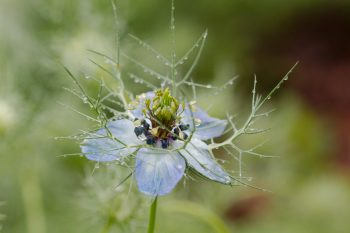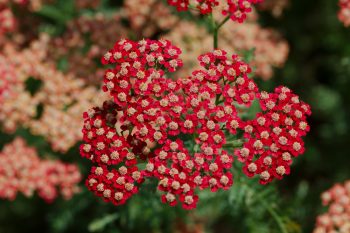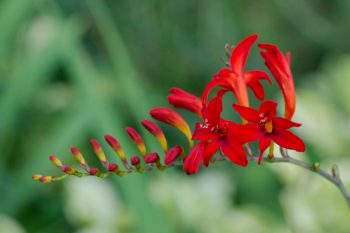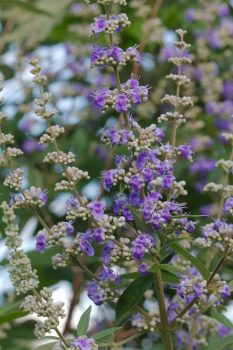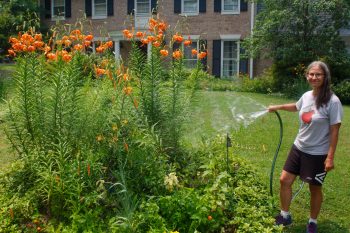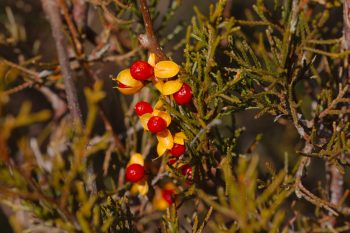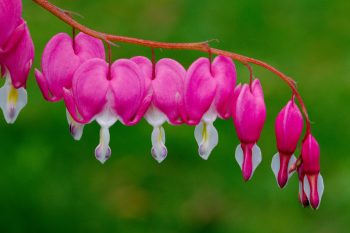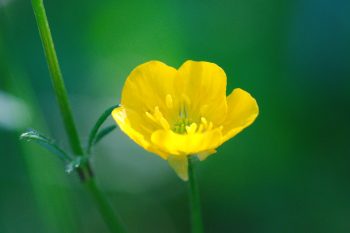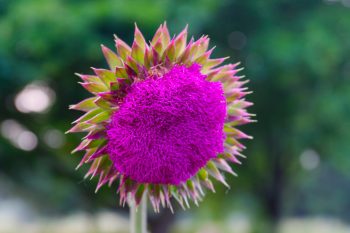We were out at Rocklands this morning with Dorothy for their chick-rental pick-up. I took a walk at one point to take some pictures of Anna’s flowers. It was a wet, cool day and there isn’t a lot in bloom at the moment but the love-in-a-mist (Nigella damascena) was blooming. The flowers are a lovely shade of pale blue and I think it’s even prettier in the rain, with water droplets on the various flower parts. This is a very hardy annual, growing well up to USDA Hardiness Zone 2, although it’s only native to northern Africa and southern Europe.
Tagged With: Non-Native Plant
Nigella damascena (Love-In-A-Mist)
Platycodon grandiflorus (Balloon Flower)
A few weeks ago we went to Stadler’s with our friend Yvette to buy a few plants for her. She wanted to plant something in memory of her nephew and wanted something blue. She settled on a balloon flower (Platycodon grandiflorus), which is actually more blue to the eye than it appears here. It’s a really pretty perennial that should do well as long as it’s got the right amount of water. We bought one, too, and have it in a container outside our front door, greeting us with these big, sky blue flowers, and reminding us of Jack, as well. It’s native to the northern far-east and is quite hardy and easily grown. The only thing to watch out for is wet or poorly-drained soils (which is why growing it in a container is easier for us).
Yarrow (Achillea millefolium)
While not a native, common yarrow (Achillea millefolium) was introduced to North America in colonial times, and has since naturalized throughout the United States. It’s considered by some to be an invasive weed, although we’ve never had a lot of luck with it surviving in our garden. This specimen is a cultivar being grown in the Master Gardener’s demonstration garden at the Agricultural History Farm Park and it’s a lovely color. It certainly makes me interested in giving it another try. There are paler versions, as well and some really nice yellows. We have plenty of yellows, though, so I think I might go for something like this.
Crocosmia ‘Lucifer’
We had this in the past but haven’t had it since we moved here in 2006. Crocosmia ‘Lucifer’—a hybrid bred by Alan Bloom and officially Crocosmia x Curtonus—has wonderful, bright red flowers and we really should plant a large clump of this. As it is, we just have a single plant but maybe we could buy some more to add to this location. It’s growing in our large, front bed and clashes a little with the otherwise purple theme of the bed, but who can complain about such a red. The species of the Crocosmia genus are mostly native to the grasslands of South Africa.
Vitex agnus-castus
We’ve talked off and on about getting a chastetree (Vitex agnus-castus). The question we haven’t answered yet is where we’d put it. I wouldn’t mind cutting down the holly that’s growing near the intersection of our front walk and driveway and putting it there, but so far, that’s just me. It would be a big change and for a little while it would make the area look comparatively empty. I think it’s worth it, frankly. I’m not a big fan of holly trees, especially when I’m outdoors barefoot and step on the leaves. Hollies are evergreen, of course, and the robins do like the berries in the winter, but those are the only real assets, as far as I’m concerned. The holly tree is a native plant, of course, but we’d have to change a lot if that was going to be a reason for growing something. It does bloom, it’s true, but the flowers are nothing compared to this. The Vitex flowers are small, but they are fragrant and are lavender to pale violet, attracting bees and butterflies in great abundance. I’m a fan of bees and butterflies.
Tiger Lilies
The tiger lilies (Lilium lancifolium) are blooming. These were all descended from bulbils that we took from lilies growing at my parent’s house. We started with just a couple and the rest came from those. We have them in a few different places in the yard but this is the largest group of them. they stand over six feet tall and they are pretty noticeable. Each year the group gets just a little larger. Last year I collected seeds, as well, although we never did anything with them. I may scatter some on our property in Pennsylvania. They should do well there.
Celastrus orbiculatus (Asian Bittersweet)
Cathy and I went for another walk after church today (that’s pretty common, as you might have noticed). This time we went to the Blue Mash Trail on Zion Road behind the Laytonsville land fill. I didn’t take many pictures and most of them were of Asiatic bittersweet (Celastrus orbiculatus) as in this photo. I particularly like this picture because of the added color of the juniper (most likely eastern red cedar, Juniperus virginiana). We have a native bittersweet (Celastrus scandens) but I’ll confess that I could not readily differentiate between the two, basically assuming that anything we see is the more aggressive C. orbiculatus.
Lamprocapnos spectabilis (Bleeding Heart)
Cathy and I went to the airport this morning to pick up Dorothy and then dropped her off in Bethesda, where she had left her car. Although it’s a little early for most azaleas, we decided to visit McCrillis Gardens, since we were near by. A few azaleas and rhododendrons were in bloom and there were other things to see. Fern fiddleheads were unrolling, there was quite a bit of Solomon seal (Polygonatum species). In the middle of the yard, under a large tree, there is a huge mound of bleeding heart (Lamprocapnos spectabilis). It’s quite pretty and we probably should plant some, if for no other reason than that it would fill in some of the gap between the early bulbs and the later spring blooms.
Buttercup (Ranunculus species)
I took a few photos in the park this evening. I got two not so good pictures of a woodpecker (Dryocopus pileatus) and some decent pictures of multiflora rose (Rosa multiflora). This photo is of a buttercup of some sort, possibly the meadow buttercup, (Ranunculus acris), but I’m not sure, exactly. That particular plant is native to Europe and Asia and is common blooming in pastures in the spring. it’s a weed, of course, and as a non-native, it’s almost certainly out of favor. But it’s still a pretty little thing.
Carduus nutans (Musk Thistle)
The musk thistle (Carduus nutans), also commonly known as the nodding or nodding plumeless thistle, is an invasive species introduced into the United States around the middle of the 19th century. It has now spread to all of the lower 48 states (with the possible exceptions of Florida, Vermont, and Maine, although I wouldn’t be surprised if it’s there, as well) and the lower provinces of Canada from British Columbia to Newfoundland. It’s a rather tall and somewhat striking plant with a large, and as you can see showy bloom. It is usually a biennial but in warmer climates can flower in its first year. Rather than there being single, large flowers, each of the purple threads in the flowerhead is technically a separate flower.
Crocosmia ‘Lucifer’
We’re back home from our grand Alaska adventure (or whatever you like to call it) and I thought I’d photograph the various things blooming in the yard. One of the best is this Crocosmia ‘Lucifer’. There are something like 7 species in the genus Crocosmia that come from the South African grasslands. The variety named ‘Lucifer’ is a hybrid by Alan Bloom (Crocosmia x Curtonus) which has flowers and foliage that are similar to gladiolus. As you can see, it has scarlet red, tubular, one-sided flowers borne along arching flower scapes. It’s one of our favorite summer blooms and every year I mean to do a little better at giving them support, although they only barely need it. We started with one or two plants and I’ve added a few more over time, so we have a nice clump of them in our front bed. We’re glad we got home while they were blooming. They attract hummingbirds, as well as the more common pollinators, which is an added treat.

